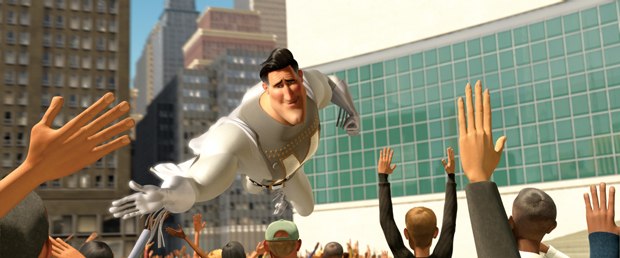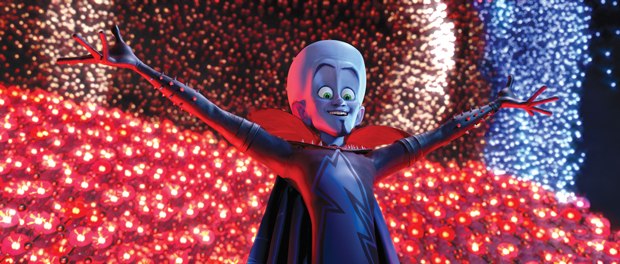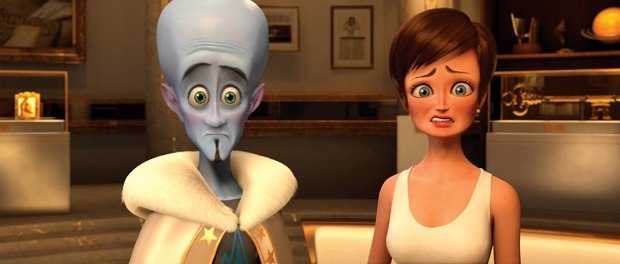Jason Schleifer and Philippe Denis guide us through the latest superhero mashup from DreamWorks Animation.
Check out the Megamind trailers and clips at AWNtv!
How do you build the ultimate super villain and at the same time make us care for him? That was the fundamental challenge with Megamind, the new action/comedy starring Will Ferrell, Tina Fey, Brad Pitt and Jonah Hill opening today through DreamWorks Animation and Paramount Pictures.
"For us it was nice to know that we were going to be doing superhero stuff, but we were also really going to be concentrating on the relationship between Megamind [Ferrell] and reporter Roxanne [Fey]," explains Jason Schleifer, head of character animation. "There are only five or six hero characters in the film so we really had to pay attention to those personalities and make sure that the audience could connect with them.
As with Madagascar, Schleifer oversaw a cross-site production that was based up north at PDI/DreamWorks with satellite work done at the Glendale campus.
With a design culled from the Jack Kirby comics, Megamind -- in a riff on Superman -- comes to Metro City as a baby with the notion that he will be a superhero, but instead becomes a super baddie. However, on earth, he has no super powers, merely a high level of intelligence and lots of enthusiasm.
"Once director Tom McGrath got on, we pursued the Alice Cooper [Megamind] and Elvis [Pitt's heroic Metro Man] routine," Schleifer continues. "They play the good guy/bad guy game to the crowd like rock stars and the citizens love to boo Megamind (who wears black leather and spikes) and cheer Metro Man (who wears white).
"There were two main animation challenges: The obvious one is the superhero challenge. How to make it unique? Both Metro Man and Tighten [Hill], Megamind's creation, have super powers. With Metro Man, who has been infinitely strong for life, how would you move in a way that would represent that, which would be interesting to watch? So we actually shot video reference of ourselves (slowed down so we could play with the frames) and did things like experimenting with how to punch somebody. We played with the timing of movements to make it not seem too cartoony. We also held on anticipation for as long as we could; then the punch would come really fast but the resolution would be slower.
"From a performance standpoint, Metro Man knows inherently how much energy he can use to, say, lift up a car without it falling apart. So we had him move really slowly so the car could build up inertia and then once it was moving, he could push it quicker. And if he was throwing a car, he knew where to place to hands to have the best possible balance and he would hold himself with a minimum amount of energy."
Although Tighten physically has the same body, rig and muscle system, he's new to the superhero game, so he's gangly and clumsy and never gets the hang of using finesse like Metro Man.
Megamind, by contrast, was immense but had to have immediate rooting interest. "When we started doing early tests, we found we were playing him too evil and it wasn't appealing," Schleifer recalls. "So we kept his brows up and played off his optimistic energy and gave him open eyes and facing the camera more so we could connect with him. He became likable. He's a master villain whose enthusiasm is infectious.
"We were much more performance driven on this show, with the aid of a lot of video reference, but we needed to find a solution to make it work with the animation, so we came up with a way of putting the video reference directly inside our proprietary animation software [Emo]. This allowed us to retime animation and almost do non-linear editing and scaling. It opened up possibilities for us to show our staging and blocking passes to the director a lot earlier. The video reference interacted with the character animation.
"We also developed muscle systems particularly for Metro Man and Tighten that would allow us to not only get good volumes on the characters as they were moving but could also animate the muscles, add jiggle and change the timing when the muscles fired to make them appear more powerful."
Actually, one of the most difficult challenges was picture-in-picture shots of characters talking through various monitors or through Megamind's Brain Bots. "We had to figure out how to get the shots in sync and allow the animators to work on them separately but to still be able to display them together for McGrath," Schleifer adds.
Meanwhile, over in the character effects department, they were working on cloth sims for capes, and immediately ran into a problem: their real world physics was at cross purposes with the more cartoony heroics. Therefore, the capes would break when stretched too far. So they had to figure out a way to deliver believable clothing that was form fitting for these super poses.
"We used Qualoth cloth simulator and put a team together to develop a cape," explains Philippe Denis, the visual effects supervisor. "We roughly rigged the position of the cape and the most challenging position was when a character grabbed the cape. We did flying tests at different speeds and frequencies to help the silhouettes of the characters and not fight the animation. It eventually worked and we cut down on the turnaround time at the end."
Again, in keeping with McGrath's mandate for believable action, Metro City (a hip re-imagining of Metropolis) was treated like a character and a new rendering technique was developed. "When you think about a city, it goes from the art department to modeling to layout, etc.," Denis adds. "But we knew that in this case it wouldn't work. So we decided to go with a procedural city. Instead of modeling the buildings, we coded them so we could change a lot of parameters. The system worked so well that at the end we used entirely procedural buildings.
"We divided neighborhoods into streets and blocks that were constantly being resized. We looked at a lot of cities and created different sizes, shapes and styles. We pulled people from different departments for this team of half a dozen. We tested the surfacing and lighting and emphasized the level of detail, keeping it in the foreground and losing it in the background.
"Visually, you go from high to low frequency detail. We also made sure the models responded well to the lighting and when it came time to the texturing, we worked on getting the right parameters."
It all came together in a night sequence where Tighten is trying to impress Roxanne with his new superpowers and drops her down to the bottom of the street before rescuing her. "We go way up high and swoop down between cars and then go right back up to the roof and there's a lot of distance changes," Denis continues. "Also, you couldn't have thousands of lights and the rendering was difficult, so we came up with a solution: interior alignment cubed maps and point-based rendering. We also inhabited the city in the background with tiny light particles. Even though you're focusing on the characters, you still feel there is life in the city."
Bill Desowitz is senior editor of AWN & VFXWorld.











